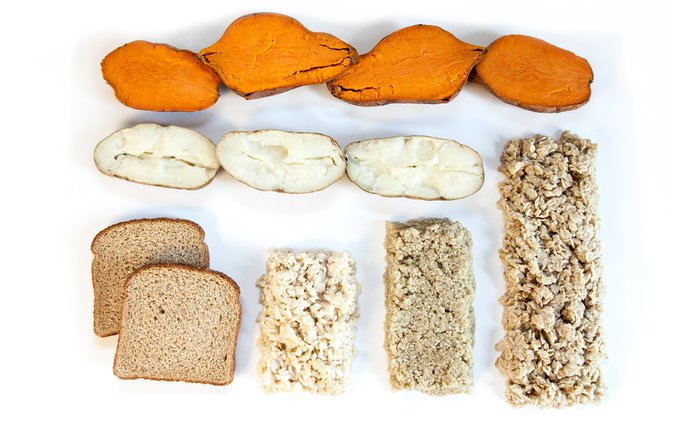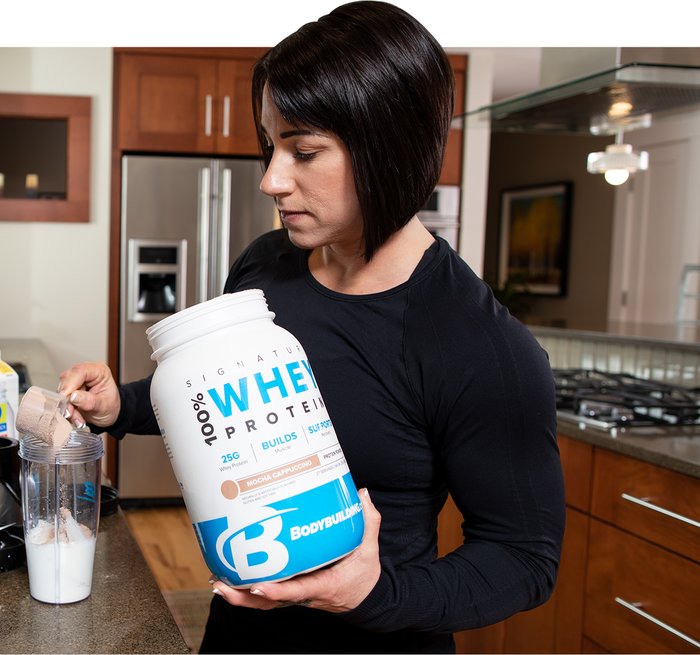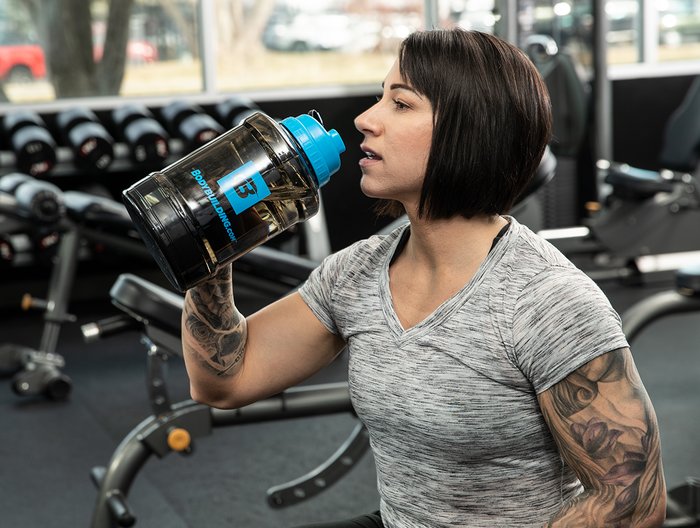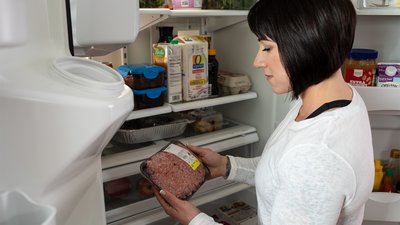Gone are the days when we believed you had to stuff your face with junk in order to crush big weights. Increasingly more athletes are realizing the value of whole foods and a well-rounded diet. If you're going to bust your ass in the gym, don't hold yourself back (or risk your overall health) with the fuel you're putting into your machine!
"What's ultimately driving the major change in nutrition is more accessibility to research-backed information. Alongside that, powerlifters are beginning to see themselves more as athletes than ever before," says Paul Salter, M.S., R.D., a Renaissance Periodization nutrition coach who has competed in two powerlifting meets himself.
The sport has grown so much that powerlifters, competitors, and hobbyists alike take it more seriously. Combine that attitude with access to more up-to-date nutrition, and lifters are wanting to get the most out of their bodies to lift as much weight as possible more than ever.
World-record powerlifter Laura Phelps, a Team Bodybuilding.com athlete, competed for many years. Now, when she coaches other powerlifters, she can guide them not only to more plates on the bar, but in what should be going on their plates in the kitchen, as well.
"Some athletes aren't eating enough or just don't have the proper balance of macronutrients," she says. "It's not about eating clean, but you do need to make sure the athlete is eating the right foods, in the right quantities, at the right times."
Here are some key basics to keep in mind when you're eating for strength:
1. Mass Moves Mass—to a Point
If you're going to be a competitor in powerlifting, it is your responsibility to get to know your body and understand where your baseline is for maintaining health and strength with adequate, quality calories.
"Protein levels need to be consistently high enough to maintain or even build muscle," says Phelps. "And there are absolutely minimum levels of carbs needed for each person to build strength and perform optimally. Quality of those carbs is critical though—highly processed and sugary carbs usually hinder performance."

As mentioned, this was not the approach to nutrition within the powerlifting community a couple of decades ago. Phelps has noticed over the past 5-10 years that the "weight moves weight" mentality is shifting, and the current top lifters are leaner, more muscular, and lifting more weight than ever.
"Prior to this, the goal was to get as big as possible, as fast as possible, and at any cost, with little regard to quality and content. But over time, more people have become educated on nutrition, and we know this isn't the best route," Phelps says.
Even so, there is still some wiggle room for fun, as the main goal of powerlifters is not body composition, it's strength (duh). Don't completely turn away from the foods that give you life and help you keep your sanity, too. This is not a sport of deprivation.
"Moderation and flexibility should be pillars," Salter says. "I think just giving yourself permission to enjoy foods you love in moderation should be part of that foundation. No foods should ever be off limits."
2. Calculate the Right Amount of Carbs for You
If you're active on social media, you've likely noticed the wide spectrum of opinion between lifters and coaches who advise eating all the carbs and those who suggest that you can perform well on low-carb diets. So, who's right?
"Simply put, carbohydrates are key players in brain function and muscle contraction," Phelps says. "To sustain and perform optimally during intense anaerobic workouts, sufficient levels of quality carbs are important. But during training phases where the athlete has adequate rest periods between sets, super high levels of carbs are not really necessary."

Salter agrees. In a higher-volume hypertrophy phase, he recommends 1.2 grams of carbs per pound of body weight for a workout that takes roughly an hour. That bumps up to 1.5-1.6 grams per pound of body weight for a 90-minute training session, or even up to 2 grams per pound for a two-hour workout (but remember, you're working…not just sitting around half the time).
Again, this is individualized and likely will need to be dropped when you're transitioning into a strength phase.
3. Avoid Critical Mistakes on the Day of Your Meet
Salter wishes he had a blooper reel of all the meet-day nutrition nonsense he has seen over the years. Hint: Copious amounts of donuts or burritos between lifts probably isn't your best bet.
"Many powerlifters treat meets like an endurance event because they are long, but it's not like a marathon, where you are exercising nonstop," Salter says. "You do need good carbs for energy, though, so focus on lower-fiber foods that digest quickly and won't feel heavy in your stomach. Think rice cakes, Quaker Chewy Bars, pretzels, or kids' cereals."
If you're competing in a federation that does two-hour weigh-ins, Salter recommends consuming a protein powder and liquid carbohydrate like Gatorade after weigh-ins. This is easy to digest, provides a good number of calories, and helps with hydration. If you're doing a 24-hour weigh-in, eat as normal but keep focused on whole, nutrient-dense foods. Carbing up with Olive Garden pasta and breadsticks the night before isn't going to give you any sort of advantage—but it might make you feel like hell.

"I was one of those lifters who didn't do well with heavy foods, so my go-to snacks were rice cakes, baby food packets, bananas, peanut butter and jelly sandwiches, and carbohydrate drinks," Phelps says.
Both Salter and Phelps also agree that meet day is not the time to try new foods. Nothing you eat is worth potentially affecting your performance on the platform.
4. Water and Sodium Intake
Ever thought you were adequately fed and slept a solid 7-8 hours, but your lifts still felt like crap? Check your water intake.
"Hydration is critical for anaerobic performance and recovery. It is scientifically proven that muscles contract faster when properly hydrated and have balanced calcium, potassium, and sodium levels, as well," Phelps says. "Much of your electrolyte balance can be controlled through food and water intake."
"Salt is bad for you" is a mantra, and it typically refers to the added sodium that comes from eating too many processed foods. Adding salt to your food is fine—helpful, even. Salter suggests lightly salting all of your meals or even drinking a sports drink during training.
"Your muscles are 75 percent water, and dehydrated muscles can lead to a 2-10 percent decrease in strength. Obviously, that's the opposite of what a powerlifter is going for," Salter says. "You don't need to rigorously track your sodium intake, but it's going to help optimize fluid balance and overall hydration in the body. At least be mindful of it."
Not sure if you're hydrated enough? Track your water intake for a few weeks. You may be drinking less than you think!

5. Meal Timing—Does It Matter?
This is a topic that has grown in popularity over the past few years. We can all agree that there's no one "right" way to eat, but when you eat could make a huge difference in your performance. To have your macros down is one thing; to time them right could open up a new world of better training sessions.
"Keeping your personal macro profile in mind, center your carbs around your workouts: 20-30 percent of your daily carbs before for glycogen stores and sustained energy throughout, and 25-35 percent of them after to replenish them," Phelps advises.
Don't worry so much about the number of meals you have a day, but do try to eat every 3-5 hours. If you're training hard and compete at a high level with advanced training demands, you may even benefit from intra-workout carbs—although, again, you want to stick with quick-digesting sources.
Bottom Line: Eat Like an Athlete
While all this information is vital for powerlifters, it can be applied to almost any strength athlete or lifter. Salter is of the mind that nutrition with these guidelines really is universal.
"There is no magic formula required for powerlifters that makes their nutrition drastically different," he explains. "If they view themselves as an athlete, they should invest in their nutrition and nutrition knowledge to optimize performance in recovery. Find the right resources to set up a plan, and then prioritize having enough fuel before, during, and after workouts."
Be smart with your food choices, do your research, and lift heavy.
Want to learn more about foundational nutrition for whatever your goal may be? Take our Foundations of Fitness Nutrition course, available exclusively on Bodybuilding.com BodyFit Elite.

